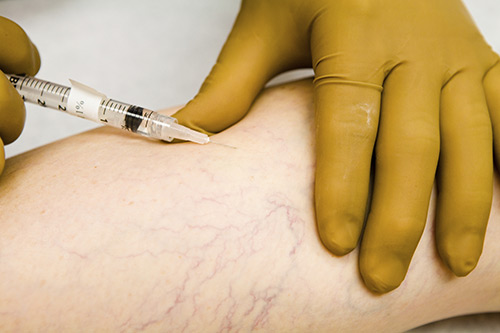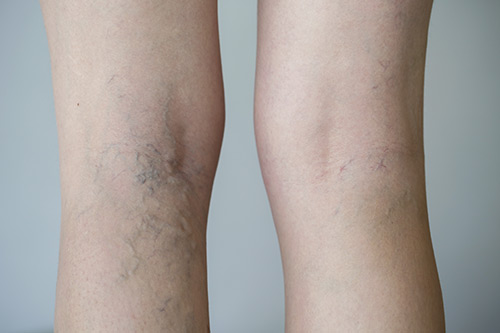Sclerotherapy
Sclerotherapy
What is a sclerotherapy?
Sclerotherapy or Laser Vein Treatment is a simple non-surgical procedure performed by Dr. Grishkevich to “erase” spider veins, which are small clusters of red, blue, or purple veins, or larger varicose veins. During the Sclerotherapy procedure, or Laser Vein Treatment, veins are injected with a sclerosing solution, which causes the vein to close off and fade from view.
Spider veins are commonly found on the calves, thighs and ankles. They can be especially noticeable and unsightly when you are wearing shorts, dresses, skirts, or a bathing suit.
Typical symptoms of spider veins or larger varicose veins are itchy, bulging, swollen, or restless legs. Heredity, pregnancy, hormonal changes, trauma, weight gain, and prolonged sitting or standing are all sources that contribute to the development of both spider veins and varicose veins.
The Consult
During your Sclerotherapy or Laser Vein Treatment consultation with Dr. Grishkevich, he will discuss the options and alternatives in great detail, providing you with all the information you need to make an informed decision about this non-surgical procedure.
Dr. Grishkevich will begin the consult by identifying the cause of your spider veins using the latest diagnostic technology. Once the source is found, he will recommend the Sclerotherapy or Laser Vein Treatment that will achieve the best results for you. It typically takes 3-5 treatments per region to achieve optimum results.
About The Procedure
Sclerotherapyor Laser Vein Treatment is performed by Dr. Grishkevich is an out-patient procedure under local topical anesthesia; each procedure typically takes approximately 30 minutes.
Sclerotherapy or Laser Vein Treatment involves injecting a pharmaceutical–called a sclerosant–you’re your problem veins. The sclerosant causes the veins to scar and collapse so blood no longer fills them. The body will absorb the diseased veins and reroute your blood to healthy veins within a few weeks.
Some of Dr. Grishkevich’s patients also combine their Sclerotherapy or Laser Vein Treatment with other cosmetic or plastic surgery procedures, such as BOTOX® or injectable dermal fillers ( Juvederm, Radiesse, Restlane / Prelance and Fat Transfer), Fraxel Laser, chemical peels, laser hair removal, and skin care. NOTE: If patients are having a facelift / neck lift, browlift / forehead lift, eyelid surgery, or nose job cosmetic procedure in the Operating Room, they can choose to add a BOTOX® injection or an injectable dermal filler.
Recovery
 After a Sclerotherapy procedure or Laser Vein Treatment, patients can resume normal daily activities and walking is encouraged to prevent blood clots. You will wear support to compress the treated vessels for one week after treatment to keep blood blow out of the treated veins.
After a Sclerotherapy procedure or Laser Vein Treatment, patients can resume normal daily activities and walking is encouraged to prevent blood clots. You will wear support to compress the treated vessels for one week after treatment to keep blood blow out of the treated veins.
Dr. Grishkevich recommends that you avoid strenuous activities the evening after the procedure, but you will have no additional restrictions after that. You should avoid hot baths, whirlpools, saunas, hot compresses, and direct exposure to sunlight for 48 hours after treatment.
Common side effects can include itching for 1 to 2 days after the procedure. The injection site may become raised and red, with some bruising, but should disappear in a few days.
Dr. Grishkevich will schedule a follow-up post-recovery office visit to discuss your progress.
To learn more about Sclerotherapy procedures or Laser Vein Treatment, please call us today at 503-513-5533 or complete this form on our website to schedule an initial consultation.
Detailed info
THE DETAILS
Sclerotherapy uses an injection of a special chemical (sclerosant) into a varicose vein to damage and scar the inside lining of the vein. This causes the vein to close.
 During this procedure, the affected leg is elevated to drain blood, and the sclerosant is injected into the varicose vein. The procedure is done in a doctor's office or clinic and takes 5 to 30 minutes, depending on how many varicose veins are treated and how big they are.
During this procedure, the affected leg is elevated to drain blood, and the sclerosant is injected into the varicose vein. The procedure is done in a doctor's office or clinic and takes 5 to 30 minutes, depending on how many varicose veins are treated and how big they are.
After the injection of sclerosant is given, pressure is applied over the veins to prevent blood return when you stand up. You may need to wear compression stockings for several days or weeks to maintain the pressure.
The sclerotherapy injection may be painful, and the chemical (sclerosant) that is injected can cause a feeling of burning or cramping for a few minutes in the area where the shot was given. You may need repeated sessions and many injections each session, depending on the extent of the varicose veins and type of sclerosant used.
A newer, minimally invasive technique allows your doctor to inject sclerosant with a catheter. The catheter and sclerosant are guided to the affected vein with the help of duplex ultrasound. This process allows sclerotherapy treatment to be used on larger varicose veins that previously could only be treated surgically with ligation and stripping, in which larger varicose veins are tied off and removed.
What To Expect After Treatment
Sclerotherapy generally does not require any recovery period. You will likely be able to walk immediately after the treatment, but you should take it easy for a day or two. Bed rest is not recommended, but you may need to avoid strenuous exercise for a few days after sclerotherapy. Avoid exposing your legs to the sun for the first 2 weeks after the procedure.
You will probably have to wear compression stockings for a short time after having sclerotherapy.
Why It Is Done
Sclerotherapy is used to treat:
- Spider veins and small veins that are not causing more serious problems.
- Smaller varicose veins that come back after vein-stripping surgery.
- Larger varicose veins, when minimally invasive techniques are used.
Sclerotherapy may be done alone or as a follow-up to surgery.
Sclerotherapy should not be done if you:
- Are pregnant or nursing. It is not known whether the chemical (sclerosant) causes birth defects or gets into breast milk.
- Have a history of allergy to sclerosant or similar substances.
- Have blood clots or inflammation in the deep leg veins (deep vein thrombosis).
How Well It Works
Sclerotherapy costs less than surgery, requires no hospital stay, and allows a quicker return to work and normal activities.
Sclerotherapy can reduce symptoms and improve the look of the skin. It works in about 80 out of 100 people. It doesn't work for about 20 out of 100 people who have the procedure.1
Risks
The risks of sclerotherapy include:
Skin color changes along the treated vein. This is the most common side effect of sclerotherapy. The discoloration may take 6 to 12 months to disappear. In some people, it may be permanent. Failure of treatment to prevent varicose veins from returning. Itching, bruising, pain, and blistering where the veins were treated. Scarring resulting from ulcers or death of the tissue around the treated vein (skin or fat necrosis) if sclerosant is injected outside a vein or sclerosant escapes through the wall of a weakened vein.
A mild or severe (anaphylactic) reaction to the sclerosant. (Severe reaction is very rare but can be life-threatening.) Blood clots or damage in the deep vein system.
from WebMD.com
FAQ
How is sclerotherapy performed?
In sclerotherapy, medication is injected into the unwanted vein to cause it to close. The medication displaces the blood, causes the vein to appear lighter and irritates the lining, causing it to collapse. Bandages create external compression, keep the vein closed and prevent blood from flowing to it. Within a month, the vein is absorbed by the body and disappears. We perform sclerotherpay in our office. Anesthesia isn’t needed. The procedure isn’t painful, but the individual injections can cause a slight burning sensation that lasts a few seconds.
What can I expect after sclerotherapy?
We’ll wrap your leg in a compression bandage or support stocking. Usually you can remove the compression and resume normal activities in 24-48 hours. You might experience bruising and the injection site could be tender for a day or so. Your legs will look worse before they look better. But, you’ll see significant improvement in about a month. Some veins require retreatment, and new varicose or spider veins may form.
How do I prepare for sclerotherapy?
Please don’t use lotion or oil on your legs for 24 hours before sclerotherapy. And, shave your legs the night before. Avoid exposure to the sun for a month before and after treatment to help reduce the chance of dark pigmentation forming at the injection site. Bring a pair of shorts to wear during the procedure and plan to wear loose pants, sweats or a skirt to accommodate the compression bandages.
How long does the treatment take? How many treatments will I need?
Please arrive 15 minutes early to check in and prepare for the procedure. The treatment itself takes 20-30 minutes. The number of treatments varies from patient to patient. Many need just one session. If multiple sessions are needed, we’ll schedule them a few weeks apart.
What are the most common side effects?
- Mild itching
- Hyperpigmentation, a light brown discoloration of the skin along the vein in the injection area. It will fade in a few weeks, but could take a year to disappear entirely. Sometimes, a small amount of blood is trapped, hardens in the vein and looks dark blue or bruised. You may need to have this area drained before your next treatment.
- New, fine spider veins may occur. If untreated, they may disappear within a year or can be treated with sclerotherapy.
- Temporary tenderness or bruising at the injection site.
What are the less common side effects?
- Ulceration at the injection site, which usually heals within six weeks, and may result in a small scar.
- Allergic reaction. Be sure to tell us about all allergies.
- Pulmonary embolus or deep vein thrombosis, a blood clot to the lungs or deep vein. This complication is extremely rare.
How much does sclerotherapy cost and will my insurance cover it?
Costs vary, depending on how many treatments you need. Sclerotherapy is usually considered a cosmetic procedure and isn’t covered by insurance. However, some symptomatic veins may qualify for insurance coverage. Check with your health insurance plan for complete details.
Will sclerotherapy work for me?
Varicose veins shouldn’t grow back after effective treatment. However, we can’t alter heredity and aging. And, some patients experience recurrence. We can retreat varicose veins with sclerotherapy or other procedures. This isn’t just cosmetic maintenance, but improves circulation and relieves symptoms.
What other options do I have?
- You can choose to forego treatment. The varicose and spider veins may progress and new ones may form. You should have periodic reevaluations.
- Your doctor might suggest support hose to promote circulation. Or, if you have larger varicose veins, surgical stripping could be appropriate.
- Endovenous laser ablation (ELA) is an alternative to surgical stripping. Please talk with Dr. Grishkevich to discuss your options. How will I feel after sclerotherapy?
You might experience temporary itching or cramping. Your leg will be wrapped with a compression bandage. When the wrap is removed, you may notice bruising and discoloration. This will fade over a few weeks.
Can I exercise after treatment?
You should avoid activities that put pressure on the treated area (like heavy lifting or jogging) for a few days. But, your doctor might suggest a walking program to increase circulation and promote healing.
After a few days, exercise is encouraged. People who use their leg muscles every day heal faster and have fewer complications and less discomfort. The simplest, most effective exercise for good vein function is walking.
Does sclerotherapy cause stains on the skin?
Temporary brownish discoloration is common. It’s caused by a pigment released in the skin from veins in the process of disintegrating. These stains take up to several months to fade, depending on the size of the veins, your skin type and your individual healing ability.
Are the results of treatment with sclerotherapy temporary?
It’s possible for someone with a hereditary predisposition to develop new varicose veins after either surgical or non-surgical treatment. But, generally speaking sclerotherapy is extremely effective in permanently closing off varicose and spider veins. Veins lighten after each treatment.
from Providence Health&Service

 based on
based on 